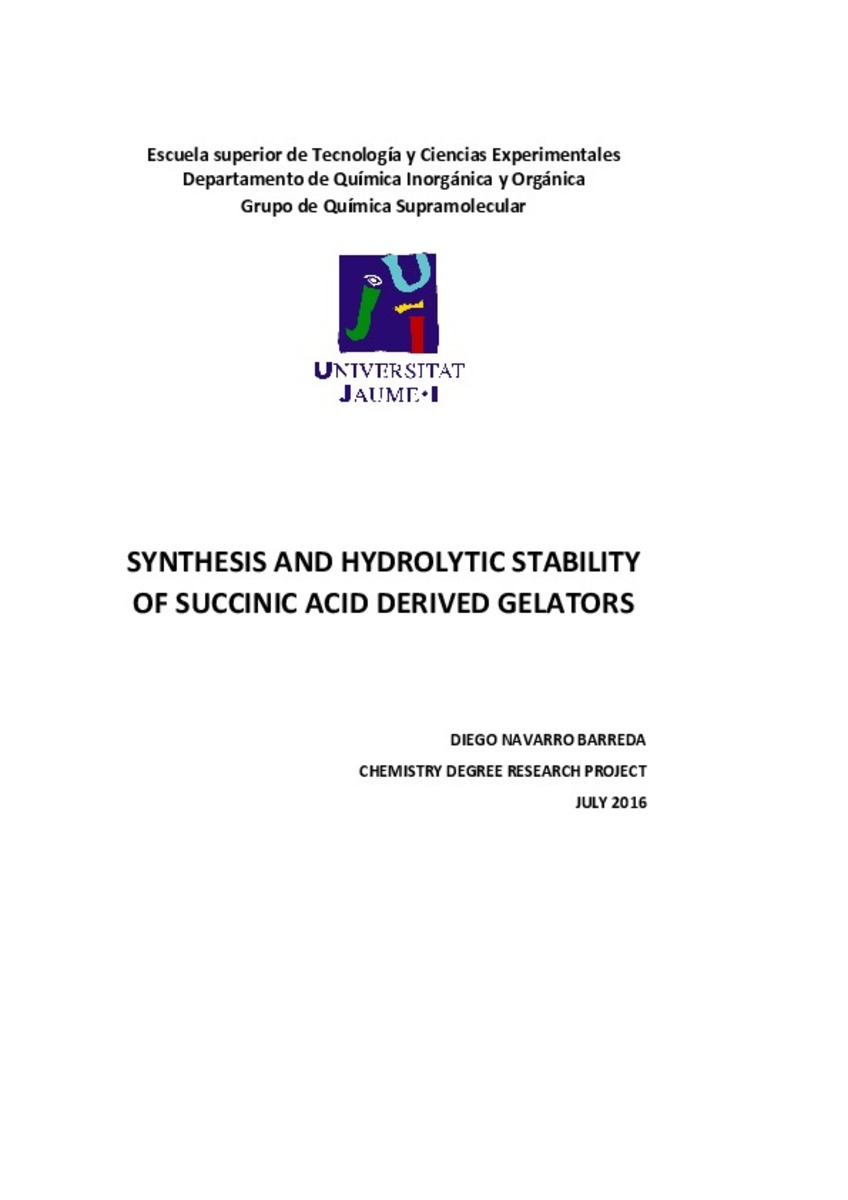Mostrar el registro sencillo del ítem
Synthesis and hydrolytic stability of succinic acid derived gelators
| dc.contributor | Miravet Celades, Juan Felipe | |
| dc.contributor.author | Navarro Barreda, Diego | |
| dc.contributor.other | Universitat Jaume I. Departament de Química Inorgànica i Orgànica | |
| dc.date.accessioned | 2016-11-10T11:44:23Z | |
| dc.date.available | 2016-11-10T11:44:23Z | |
| dc.date.issued | 2016-07-28 | |
| dc.identifier.uri | http://hdl.handle.net/10234/164351 | |
| dc.description | Treball Final de Grau en Química. Codi: QU0943. Curs: 2015/2016 | ca_CA |
| dc.description.abstract | Gels pervade our daily life in a variety of forms such as agents in cosmetics and pharmaceutical formulations, as well as cleaning products or food. A very wide range of materials have been recognised since the 1860's to form gels, often with quite different characteristics. But, due to its variety and complexity of the diverse systems it is not easy to write an absolute definition of gel. Dorothy Jordon Lloyd wrote in 1926 that "the gel state is easier to recognise than to define". The reason lies in the fact that there is usually not a minimum of physical parameters that allow one to write a clear-cut definition, however the designation of a substance as a gel is only a visual observation (if no flow is observed, the solution is said to have become a gel). Generally, gels are predominantly liquid in composition. Typically, 99% by weight of the gel is a solvent while the remaining 1% is the gelator. And the solid-like appearance of a gel is a result of the entrapment and adhesion of the solvent in the large surface area solid 3D matrix formed by the gelator. Gels can be classified in different ways depending on their source, medium, constitution or type of interaction that creates their 3D network. | ca_CA |
| dc.format.mimetype | application/pdf | ca_CA |
| dc.language.iso | eng | ca_CA |
| dc.publisher | Universitat Jaume I | ca_CA |
| dc.rights | Atribución-NoComercial-CompartirIgual 4.0 España | * |
| dc.rights.uri | http://creativecommons.org/licenses/by-nc-sa/4.0/ | * |
| dc.subject | Grau en Química | ca_CA |
| dc.subject | Grado en Química | ca_CA |
| dc.subject | Bachelor's Degree in Chemistry | ca_CA |
| dc.subject | Geles | ca_CA |
| dc.subject | Química supramolecular | ca_CA |
| dc.subject | Ácido succínico | ca_CA |
| dc.subject | Síntesis orgánica (Química) | ca_CA |
| dc.subject.lcsh | Gels (Farmàcia) | ca_CA |
| dc.subject.lcsh | Supramolecular chemistry | ca_CA |
| dc.subject.lcsh | Synthesis | ca_CA |
| dc.title | Synthesis and hydrolytic stability of succinic acid derived gelators | ca_CA |
| dc.type | info:eu-repo/semantics/bachelorThesis | ca_CA |
| dc.educationLevel | Estudios de Grado | ca_CA |
| dc.rights.accessRights | info:eu-repo/semantics/openAccess | ca_CA |
Ficheros en el ítem
Este ítem aparece en la(s) siguiente(s) colección(ones)
-
Grau en Química [265]
QU0943








